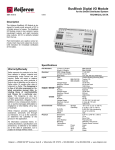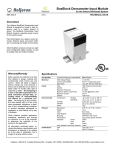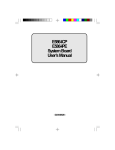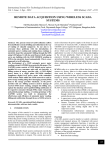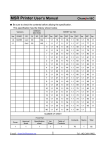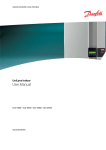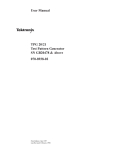Download Push Button Controller for SDS - 300
Transcript
Push Button Controller for the Smart Distributed System PBC-5030-1 TECHNICAL DATA 0104 Description The Holjeron Push Button Controller for SDS provides a convenient method to connect push button stations in a Smart Distributed System installation. The Push Button Controller provides six (6) inputs and four (4) outputs. Inputs and outputs use bus power for their voltage source. The Push Button Controller can be purchased as a stand-alone card, or with different brackets, depending on the application. Holjeron can also design brackets to meet specific packaging requirements. Warranty/Remedy Seller warrants its products to be free from defects in design, material and workmanship under normal use and service. Seller will repair or replace without charge any such products it finds to be so defective on its return to Seller within 18 months after date of shipment by Seller. The foregoing is in lieu of all other expressed or implied warranties (except title), including those of merchantability and fitness for a particular purpose. The foregoing is also purchaser’s sole remedy and is in lieu of all other guarantees, obligations, or liabilities or any consequences incidental, or punitive damages attributable to negligence or strict liability, all by way of example. While Holjeron provides application assistance, personally and through our literature, it is up to the customer to determine the suitability of the product in the application. All information contained herein, including illustrations, specifications and dimensions, is believed to be reliable as of the date of publication, but is subject to change without notice. Specifications Part Number DeviceNet Inputs Outputs Environmental Physical Push Button Controller Only PBC with Mini Bulkhead Bracket PBC with 22.5 mm Bracket PBC with 30.5 mm Bracket Voltage Range Current Consumption Data Rates Type Number Voltage Range Maximum Current Type Number Voltage Range Maximum Current Temperature Storage Operating Humidity Vibration Shock Dimensions (card only) Weight Mounting SDS300-05 SDS300-22 SDS300-30 Terminations Indication Status Activity PBC-SDS300 PBC-SDS300-05 PBC-SDS300-22 PBC-SDS300-30 11-25 VDC 60 mA plus inputs and outputs 125, 250, 500 and 1000 kbps Open collector Six (6) 11-25 VDC (bus voltage) 20 mA per input Current Sourcing Four (4) 11-25 VDC (bus voltage) 200 mA -30° to 70° C (-22° to 158° F) 0° to 60° C (32° to 140° F) 5-95% RH, non-condensing 2G at 10 to 500 Hz 10G 2.79" H x 2.00" W x 0.38" W 6 oz Mini bulkhead bracket 22 mm button mount bracket 30 mm button mount bracket Pluggable terminal block, 17 pos. Red/Green Green Holjeron • 25599 SW 95th Ave. Suite E • Wilsonville, OR 97070 • 503.582.0820 • Fax 503.582.9166 • www.holjeron.com Push Button Controller for the Smart Distributed System PBC-5030-1 TECHNICAL DATA Page 2 Dimensions Wiring PBC-SDS300 Only 17 Note 1 17 Pos Pluggable Terminal Wire Entry Opposite Side Outputs use SDS power. Lamp current consumption must be considered when calculating the total power used by an SDS network. 0.50 2.00 No Components Reserved for Mounting Component Side LEDs 1.34 In 0 0.38 Ø 0.156 In 1 0.38 In 2 Input Wiring (Typical of 6) 0.156 2.44 In 3 In 4 0.156 0.156 In 5 2.75 V+ Out 0 PBC-SDS300-05 Out 1 Output Wiring (Typical of 4) Out 2 Out 3 V+ BUS V+ BUS + SHIELD BUS BUS V- 1.00 DeviceNet Connector Hole for Bulkhead 3.50 in. Minimum Enclosure Width Holjeron • 25599 SW 95th Ave. Suite E • Wilsonville, OR 97070 • 503.582.0820 • Fax 503.582.9166 • www.holjeron.com Push Button Controller for the Smart Distributed System PBC-5030-1 Page 3 Configuration Tools Quick Start A Push Button Controller can be configured using several tools. The information below summarizes the configuration tools available and hardware requirements for each tool. The following steps are the minimum steps to configure Push Button Controller. Default values are shown in bold typeface. Holjeron Device Manager for SDS Requires an HSIM Portable (RS-232 to CAN converter) that connects to the serial port of a personal computer. The bus or the HSIM Portable must have power. TECHNICAL DATA Set Device Address Using one of the tools described above, change the device address from the default. All units are shipped from the factory as address 126. Note Set the address before attaching any component to a complete bus. This will help prevent duplicate addresses on a bus. Honeywell hand-held activator The Honeywell activator may not supply enough power by itself. The SDS bus might require external power to be applied. Think & Do Software Requires a Honeywell PC Interface Card with separate bus power. Follow the instructions for installing the SDS Driver in I/O View. Tag Name Tag Name (attribute 56) is a 32character string that the user can enter to describe the functionality and/or location of each channel of the Push Button Controller. Holjeron • 25599 SW 95th Ave. Suite E • Wilsonville, OR 97070 • 503.582.0820 • Fax 503.582.9166 • www.holjeron.com Push Button Controller for the Smart Distributed System TECHNICAL DATA PBC-5030-1 Page 4 Input/Output Variables Input NO/NC Flash Time (0-3) The Push Button Controller can be configured to invert the state of an incoming input point by turning on the corresponding bit in Input NO/NC (attribute 60). The Flash Time (attributes 64-67) set the rate at which the output will alternate between on and off states when both the output and corresponding flash bits are set to 1. The time is entered in 10 millisecond increments (100 = 1 second). Input Event Mode For example, if attribute 64 has a value of 50 when bits 0 and 4 in the output variable are both enabled, output 0 will alternate states every ½ second. Note When using a packaged control system, such as Think & Do Software, it is not necessary to explicitly read input and output variables. The SDS I/O Driver and Interface Card perform this function. All that is required is to map inputs and outputs as described in the software user manual. Attribute 18 functions as the input attribute for the Push Button Controller. Whenever an event is generated that reports the state of inputs, the data in attribute 18 will be passed. Bit 0 1 2 3 4 5 6 7 Name Input 0 Input 1 Input 2 Input 3 Input 4 Input 5 Reserved Reserved Description State of physical input 0 State of physical input 1 State of physical input 2 State of physical input 3 State of physical input 4 State of physical input 5 Alternate Action Mask Attribute 34 functions as the output attribute for the Push Button Controller. Whenever the host controller changes the state of an output it is inherently writing to attribute 34. Bit 0 Name Output 0 1 Output 1 2 Output 2 3 Output 3 4 Flash 0 5 Flash 1 6 Flash 2 7 Flash 3 Most systems will require a Push Button Controller to generate an event whenever one or more inputs change state. This requires the Unsolicit Mode (attribute 6) be enabled by setting its value to 1. Other options are to disable change of value events (Unsolicit Mode = 0) or use the Cyclic Timer (Attribute 10) by setting it to some non-zero value. The Cyclic Timer will transmit the input variable on an interval equal to the value in the Cyclic Timer attribute times 10 milliseconds (0.01 seconds). Description Controls the state of physical output 0 Controls the state of physical output 1 Controls the state of physical output 2 Controls the state of physical output 3 When enabled concurrently with Output 0 causes Output 0 to flash. When enabled concurrently with Output 1 causes Output 1 to flash. When enabled concurrently with Output 2 causes Output 2 to flash. When enabled concurrently with Output 3 causes Output 3 to flash. When a bit in the Alternate Action Mask (attribute 63) is set to a value of 1 and the physical input with the same bit number turns on, the value reported in the input variable will change state and remain in that state until the physical input is cycled. Push-To-Test Mask When a bit is set to 1 (enabled) in the Push-To-Test Mask (attribute 70), and the input with same bit number is on, all outputs will be energized to test lamps in the system. Holjeron • 25599 SW 95th Ave. Suite E • Wilsonville, OR 97070 • 503.582.0820 • Fax 503.582.9166 • www.holjeron.com Push Button Controller for the Smart Distributed System TECHNICAL DATA PBC-5030-1 Page 5 Diagnostics CHKSUM FBULB A ROM checksum error is generated on power up if there is a memory error test. The Push Button Controller contains circuitry that determines whether a lamp is missing or burnt out. Setting each bit in the Lamp Test Mask (attribute 68) that corresponds with outputs that are driving lamps enables the lamp test for that output. The Diagnostic Register (attribute 9) is two bytes and contains the minimum diagnostics required for the Smart Distributed System, plus additional diagnostics specific to the Push Button Controller. Diagnostic Register Bit Definitions Byte 0 Bit 0 1 Name CHKSUM WDOG 2 BUSOFF 3 4 5 6 7 DEVERR NODE RSVD RSVD EPRM Description ROM checksum error Output watchdog timer expired Off us communications error Fatal component error Missing node detected Reserved Reserved EEPROM error detected Diagnostic Register Bit Definitions Byte 1 Bit 0 1 Name RSVD FBULB 2 3 4 5 6 7 RSVD RSVD RSVD RSVD RSVD RSVD Description Reserved Failed Bulb Test. The specific bulb is identified in attribute 69. Reserved Reserved Reserved Reserved Reserved Reserved SDS host controllers are equipped to receive a diagnostic event, then automatically obtain the information from the Diagnostic Register (attribute 9). Consult the documentation for the host controller being used to determine how errors are handled. WDOG The WDOG diagnostic occurs whenever the Output Watchdog Timer (attribute 50) times out. The Output Watchdog Timer is reset whenever the Push Button Controller receives a message over SDS. If a message is not received in the time entered any point configured as an output will be set to the state for that bit in the Default Output (attribute 51). When the lamp test is enabled for an output and the lamp is missing or burnt out the Failed Lamp Register (attribute 69) will contain a value of 1 in the bit location that corresponds with that output. The Output Watchdog Timer is entered in increments of 10 milliseconds (0.01 seconds). For example, a value of 100 equals 1 second. Device Monitoring In addition to diagnostic events, there are two attributes that can be used to monitor a node for maintenance purposes. BUSOFF The CAN controller on the Push Button Controller counts error messages. Every error message increments a counter by 8, every good message decrements the counter by 1. If the counter reaches 128 then the module will go BUSOFF. The microcontroller on the PBC will attempt to reset if a BUSOFF occurs. If the PBC is unable to reset itself, it will need to be reset by the host controller. Reset Count The Reset Count (attribute 53) is the number of times the microprocessor on the Push Button Controller has been reset, including power cycles and resets from fault conditions. A unit on a bus that has a higher reset count than other nodes on the same bus may be experiencing communications difficulties. DEVERR The DEVERR diagnostic bit will be set if a fatal error is detected within the component. NODE Service Time Service Time (attribute 54) is the number of hours the Push Button Controller has been in operation. The host controller will report the node is missing using the NODE bit. EPRM The EPRM error will occur when the microprocessor on the Push Button Controller is unable to read or write EEPROM. Holjeron • 25599 SW 95th Ave. Suite E • Wilsonville, OR 97070 • 503.582.0820 • Fax 503.582.9166 • www.holjeron.com Push Button Controller for the Smart Distributed System PBC-5030-1 Attributes Actions Events TECHNICAL DATA Page 6 R/W Data Type Size R R R R R W R R W W R R R R W R W W W R R R W W W W W W W W R W Unsigned Unsigned Unsigned Unsigned Unsigned Boolean Character Unsigned Unsigned Unsigned Unsigned Character Character Character Character Boolean Boolean Unsigned Boolean Unsigned Unsigned Unsigned Character Boolean Boolean Unsigned Unsigned Unsigned Unsigned Boolean Boolean Boolean Byte Byte Byte Word Byte Undef Undef Byte Byte Word Long Undef Undef Undef Undef Undef Undef Word Undef Word Word Byte Undef Undef Undef Byte Byte Byte Byte Undef Undef Undef Count ID Description 0 1 2 3 4 6 7 8 9 10 11 12 13 14 15 18 34 50 51 53 54 55 56 60 63 64 65 66 67 68 69 70 Network Data Descriptor Baud Rate Object Model Vendor Id Logical Address Unsolicit Mode Software Version Diagnostic Counter Diagnostic Register Cyclic Timer Serial Number Date Code Catalog Listing Vendor Description Input Variable Output Variable Output Watchdog Timer Default Output Reset Count Service Time (hours) Manufacturing Codes Tag Name Input NO/NC Alternate Action Mask Flash Time – Output 0 Flash Time – Output 1 Flash Time – Output 2 Flash Time – Output 3 Lamp Test Mask Failed Lamp Register Push-To-Test Mask ID Description Request Data Response Data 0 1 2 6 8 10 51 52 53 57 60 NOOP Change Address Self Test Clear All Errors Enroll Logical Device Change Baud Rate Force State Unforce States Read Attribute Descriptor Password Reset Factory Defaults --New logical address ------New baud rate (0…4) Input variable value --- Attribute Id Password Attribute ID, Attribute Descriptor ID Description Event Data Diagnostic Event End-Of-Timer Change of Value NOOP Number of enabled diagnostic bits in attribute 9 Attribute, Input variable Attribute, Input variable --- 0 3 6 7 6 1 5 1 1 1 12 1 2 1 1 4 32 32 32 6 8 1 8 1 1 1 32 6 6 1 1 1 1 4 4 6 Default 0 [autobaud] 9 [Holjeron] 125 1 [enabled] 0 [disabled] PBC-SDS300 Holjeron Push Button Controller 0 [disabled] 0 0 (N.O.) 0 50 50 50 50 0 0 ----Vendor Id, Serial Number Holjeron • 25599 SW 95th Ave. Suite E • Wilsonville, OR 97070 • 503.582.0820 • Fax 503.582.9166 • www.holjeron.com







